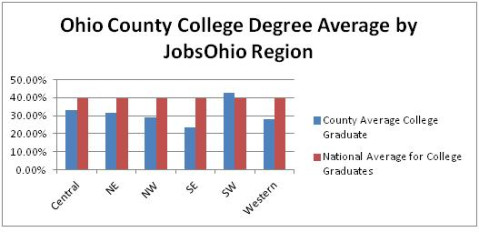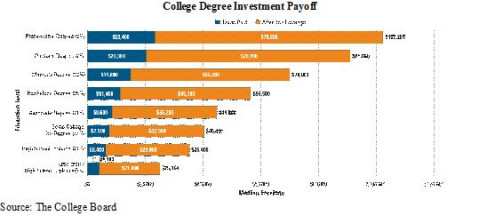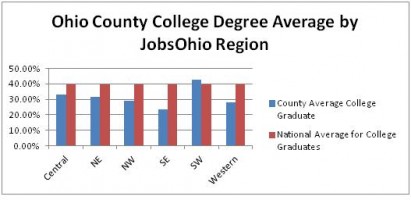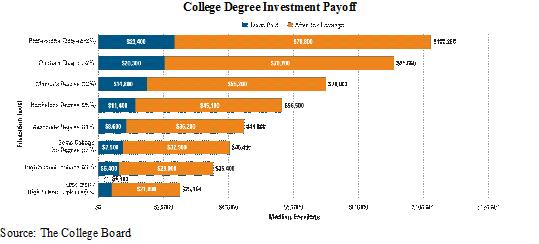Widgetized Section
Go to Admin » Appearance » Widgets » and move Gabfire Widget: Social into that MastheadOverlay zone
Higher Education and Economic Development: Addressing the Economic Talent Gap
The views expressed are those of the author and do not necessarily reflect the views of ASPA as an organization.
By David Robinson
October 24, 2014
America is on the road to economic recovery. But with 10,000 Americans reaching retirement age every day, America’s companies are facing a talent gap.
Nationally, 600,000 manufacturing jobs are waiting for skilled workers. Fifty percent of the energy industry’s 5 million skilled workers will retire within a decade. Fifty-six percent of information technology executives said there largest barrier to success is a lack of staff. Approximately 500,000 nurses and 125,000 doctors will be needed in urban and rural communities by 2020. Regions and states searching for high-growth, high-wage jobs need to address a growing talent gap.
Ohio Facing a Dangerous Talent Gap Just to Keep Existing Jobs
Ohio’s workforce challenge illustrates the workforce challenge for the American economy. OhioMeansJobs.com has listed 170,000 open jobs, with nearly 40,000 requiring a bachelor’s degree and 17,000 requiring an associate degree.
Unfortunately, Ohio is not on the path for the production of additional college and university graduates to meet this demand. A recent Lumina Foundation study proved this point. More than 60 percent of jobs in Ohio in 2020 will require some postsecondary education; only 37 percent of working-age adults in Ohio have an associate degree or higher. The Lumina Foundation study illustrates Ohio is facing a talent gap that must be addressed to meet even the current demand for workers.
Northwest Ohio Facing Large Talent Gap
Regions of Ohio are also impacted by the state’s talent gap differently. Southeast and Northwest Ohio has many great economic and quality of life attributes. Southeast Ohio is home to the Utica Shale explosion and Northwest and Western Ohio is home to a strong agricultural and manufacturing base tied to the I-75 Corridor that links Detroit to the U.S.
However, the Great Recession hit Northwest/Western Ohio hard. Rural Williams County had the highest unemployment rate in the state. According to a PNC Bank report, in 2007, Toledo’s median household income was 10 percent lower than the U.S. average and that rate jumped to 15 percent below the national average in 2013 due to the loss of additional manufacturing jobs.
Northwest/Western Ohio is behind in the production of college educated workers prepared for high-wage jobs- Toledo has only 17 percent of its residents with a college degree, Northwest Ohio counties are a full 10 percent below the 40 percent national average and only Wood County is at or above the national average.
Southeast Ohio has long been the poorest part of the state. These Appalachian counties are home to the foothills of the Appalachian Mountains but lack the wealth many other parts of Ohio enjoy. Manufacturing and agriculture have really never been mainstays for Southeast Ohio and the education levels of their residents ensured advanced service, technology or global high wage jobs would not locate in this part of the Buckeye state. Southeast Ohio has the lowest college attainment rates in the state.
The Solution: Build A College Educated Workforce
The answer to Ohio and the nation’s economic challenges is the development of a college-educated workforce. College is still a good investment. The New York Federal Reserve Bank published a recent report that found those with a college or university degree earned a return of about 15 percent above the costs. Data from the College Board illustrates those with college degrees earn more. More importantly, science, technology, engineering and math (STEM) jobs requiring a college degree pay $77,880. This is far above the U.S. average of $43,460.
To succeed long-term, America must make strategic investments in higher education, foster research and development opportunities and connect students with jobs through co-op and internship programs.
Funding for higher education needs to be a state priority. Due to the Great Recession, many states made tough budget cuts to higher education. Now that the economy is moving again, those cuts to higher education must be restored. Without adequate base funding, higher education cannot operate the programs needed to meet the talent gap.
Higher Education Funding of Select States (Illinois State University Study)
| State | Population | 2009 State Support for Higher Education | 2014 State Support for Higher Education |
| Illinois | 12.8M | $3.0B | $4.0B |
| Ohio | 11.5M | $2.4B | $2.0B |
| Georgia | 9.9M | $2.87B | $2.78B |
| North Carolina | 9.8M | $3.5B | $3.6B |
States like Ohio need to invest more in higher education. A recent statewide poll indicated the public supports this investment by a 2 to 1 margin.
Research and development at higher education institutions need to be supported to address the talent gap. Technology commercialization is the foundation of Silicon Valley and other tech regions booming. Ohio’s billion-dollar Third Frontier program is a shining example of state led technology commercialization programs that give universities, entrepreneurs, venture capitalist and business leaders a chance to lead an economic transformation around a number of key industries.
States like Ohio could turn the recent disaster with an algae bloom in Lake Erie into a research and development opportunity to fund the best ways to protect the huge source of fresh water—one of Ohio’s greatest assets. When universities become regional research and development leaders companies and high-wage job follow.
Finally, university co-op and internship program help’s Ohio companies recruit the best and brightest students. Data show that students who work as interns or in an industry co-op are hired for full time jobs. Companies love these programs because they recruit students to become workers. States interested in turning college degrees into jobs and helping recruit existing companies should fund co-op and internship programs as a prime method to address the talent gap.








Follow Us!